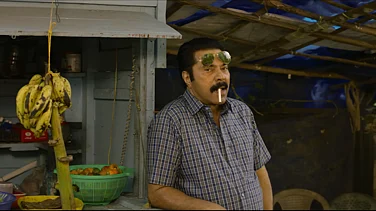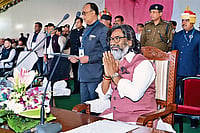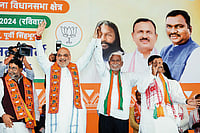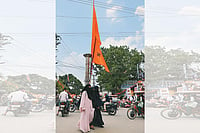A red saree with the words - “Four in Five Women Worldwide Believe Intimate Partner Violence under Certain Circumstances”; a yellow Kurta carrying some data - “Only 58% of Women in LMICs have a say on large Household Purchases”- hanging from a rope may give the impression that the clothes are left to dry after tedious wash. But certainly, it is much more than that. Accompanied by a demo kirana store run by a woman, it makes a statement on how gender inequality affects every aspect of women’s lives- ranging from economic conditions to social lives.
The exhibition curated by Abdul Latif Jameel Poverty Action Lab, commonly known as J-PAL (South Asia), at Bikaner House, Delhi walks beyond the academic jargon and brings in several themes in an interactive manner to uphold how the evidence-based decision at the policy level can impact people’s lives.

Taking a cue from their research on different sectors, the exhibition takes up different themes- health, gender, education, poverty, and environment to name a few. This is one of the first such efforts by any research organisation to display exhibits to engage people with their works. “Embedded within these exhibits are not just artefacts, statistics, and effect sizes, but a story of innovation, perseverance, impact, partnerships, trust, and a resolute commitment to uplifting millions of lives through rigorous evidence on what works and what doesn't,” says Shobhini Mukerji, Executive Director, J-PAL South Asia.
As one enters this experimental exhibition, the burden of climate change clouds the senses. On one hand, it projects the image of burning crops- considered to be one of the major reasons for Delhi’s pollution in winter; on the other, it places a shirt wrapped in plastic on an abandoned chair- representing both the vulnerabilities of human being in presence of plastic and an unavoidable apocalyptic future. The loneliness of the chair and the unattended shirt placed at the corner of the dark room as forces you to hold your breath, you can find some solutions written on different charts and posters.
The first-hand experience of the environmental crisis in that dark room leads one to the section on gender. It is conceptually divided into three sub-sections- gender attitude, better livelihood opportunities and women’s security. All of these themes came out of decades of research by J-PAL and their respective partner organisations.
In Haryana, a gender equity curriculum developed by an NGO Breakthrough found that the development of progressive gender views among adolescent boys and girls is possible through such efforts. While different women's attires embossed with significant narratives and data make it engaging for the audience, the makeshift kirana store run by women reflects on graduation approach. This approach implemented in several countries by providing ultra-poor households with a productive asset, training, mentoring, access to savings, and consumption support to help them graduate from extreme poverty.

In a country where 10% of the population lives far below the poverty line as per the World Bank, such support to the women provides them with a sustainable solution. An evaluation in West Bengal’s Murshidabad district led by Abhijit Banerjee and Esther Duflo found that the effects of the graduation approach persisted even after a decade. The consumption of the households receiving the program remained 18% higher than the comparison group.
Envisioning a better livelihood for women does not come without the assurance of women’s security. The vacant police desk placed at one corner of the room with a police uniform hung on a chair speaks volumes about the absence of women in the police services that negatively impacts the chances of women to get justice.
The sections that deal with education, health, and public distribution systems amongst others borrow the results from their research and through photographs, installations and videos make it an interactive display. One of the sections titled ‘Myth-buster’ seems to bust previously held myths on economic development. At a time when welfare schemes and direct cash transfers are considered as the major political instruments to woo the voters, there has been a consistent argument that the distribution of direct cash makes them lazy.

Busting this myth through photographs and posters that displayed research results, the exhibits focus on the ‘small supports’ that can make big changes. Saptarishi Dutta, the Senior Communication Manager, while talking about the research outcomes, says, “Both the infrastructural development and the cash transfer should go along. One cannot replace the other.”
The exhibition went on from January 4-7 and attempted to popularise mostly the social and economic policies. According to the Global Research Centre, “The exhibition stripped academic research from jargon and complex economics and made a compelling case for the value, power, and the need for using scientific methods in making policy decisions.”



























